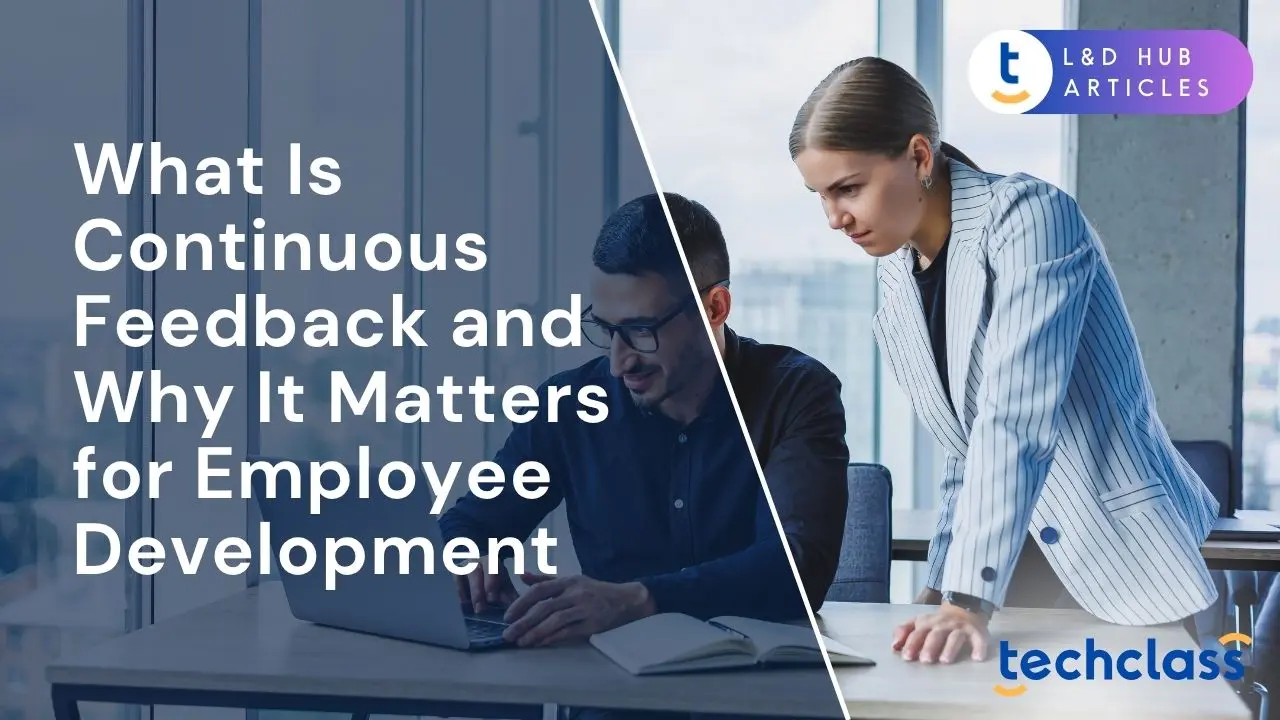
Not long ago, most companies relied on annual performance reviews to give employees feedback. These yearly evaluations often left employees waiting months for guidance, causing missed opportunities for growth. In today’s fast-paced work environment, this traditional approach has started to fall out of favor. Many organizations are shifting away from the once-a-year review cycle and toward a culture of continuous feedback. This shift is driven by a recognition that employees crave more frequent input and that businesses benefit when feedback is delivered in real time. For human resources (HR) professionals and business leaders, understanding continuous feedback is becoming essential: it promises more engaged, agile, and developed employees than the old system of retrospective annual appraisals.
In this article, we’ll explore what continuous feedback means, how it differs from traditional performance reviews, and why it’s so important for employee development. We’ll also discuss the benefits of continuous feedback, offer tips on implementing it in your organization, and look at a real-world example of success.
Continuous feedback refers to a system of providing ongoing, regular feedback to employees about their performance, goals, and development. Unlike feedback given only during annual or semi-annual reviews, continuous feedback happens throughout the year. It can take many forms, from informal one-on-one check-ins and coaching conversations to structured monthly or quarterly reviews. The common thread is that feedback is timely and frequent rather than saved up for a single review event.
In practice, continuous feedback means managers and employees communicate openly about what’s going well, what could be improved, and how the employee can grow on a continual basis. For some companies, this includes scheduled weekly or quarterly conversations; for others it may be more ad-hoc, occurring whenever a significant project finishes or a teachable moment arises. The goal is to make feedback a normal, ongoing part of work. This regular cadence ensures employees aren’t surprised by issues at year-end and can quickly adjust course or build on strengths in real time.
It’s important to note that continuous feedback doesn’t necessarily mean constant criticism or micromanagement. Rather, it emphasizes frequent, constructive dialog. Positive feedback (recognition of achievements and strengths) is as vital as corrective feedback. Continuous feedback can be manager-to-employee, peer-to-peer, and even employee-to-manager (upward feedback) in a well-rounded feedback culture. By maintaining an ongoing feedback loop, organizations aim to create an environment where coaching and development happen every day, not just once a year.
To appreciate continuous feedback, it helps to understand how it differs from the traditional annual performance review process. In a traditional model, employees often set goals with their manager at the start of the year and then wait 12 months for a formal evaluation. Feedback in this old system is usually retrospective, looking back on an entire year’s performance, and is often linked to raises or bonuses. This approach has several drawbacks: it’s slow, it can be stressful (“judgment day” syndrome), and it may not effectively guide an employee’s development throughout the year.
Continuous feedback offers a contrasting approach: feedback is proactive and ongoing. Instead of a single backward-looking review, managers and employees engage in regular conversations. For example, a manager might have brief check-in meetings with each team member monthly or quarterly to discuss progress on goals, recent accomplishments, and any obstacles. Corrections or course adjustments can be made immediately, rather than waiting months. This means that small issues are addressed before they become big problems, and good performance can be acknowledged in the moment.
Another key difference is the focus on development rather than just evaluation. Traditional reviews often emphasize rating or ranking employees, which can create anxiety or a defensive atmosphere. Continuous feedback, in contrast, fosters a more coaching-oriented mindset. The manager’s role shifts from just evaluating past performance to actively supporting the employee’s ongoing growth. Employees are encouraged to ask questions, seek advice, and share their own goals year-round.
The workplace is clearly moving in this new direction. In fact, many organizations have already begun dismantling the old review system. Studies show a significant decline in reliance on annual appraisals in recent years. For instance, one survey found that in 2016, about 82% of companies were using annual performance reviews, but by 2019 that number dropped to just over half of companies. This trend reflects growing dissatisfaction with yearly reviews and the recognition that frequent feedback is more effective in today’s work environment. In the continuous feedback model, performance management becomes a continuous cycle of goal setting, feedback, and improvement, rather than a once-yearly event.
Continuous feedback isn’t just a trendy HR idea, it has real significance for employee development. At its core, continuous feedback is about helping employees learn and grow continually. When employees receive timely feedback, they gain clarity on what they’re doing well and where they can improve while the context is still fresh. This immediate insight is invaluable for development: people can apply suggestions to their work right away, practice new skills, or adjust behaviors on the spot. Over time, this leads to faster skill acquisition and improvement compared to waiting months for guidance.
From the employee’s perspective, ongoing feedback contributes to a sense of support and engagement. They feel that their manager is invested in their progress, not just judging them at year’s end. This can significantly boost morale and motivation. In fact, research has shown strong links between frequent feedback and employee engagement. Employees who get meaningful feedback more regularly are far more engaged at work than those who do not. According to a Gallup workplace analysis, 80% of employees who received meaningful feedback in the past week were fully engaged at work. Engagement, in turn, is a driver of development, engaged employees are more willing to put in effort, try new approaches, and pursue learning opportunities.
Furthermore, continuous feedback aligns performance expectations throughout the year, which is crucial for development. Instead of potentially being off-track for months, employees get frequent check-ins to ensure they are developing the right skills and focusing on the right goals. It creates an agile environment where goals can be refined and learning objectives updated as business needs change. This agile development approach is especially important in fast-moving industries or roles, where waiting a whole year to course-correct could mean missed targets or outdated skillsets.
For HR professionals and leaders, continuous feedback also provides ongoing data points about an employee’s growth. Rather than one snapshot at review time, managers gather a richer narrative of performance and progress. This continuous performance insight allows for more personalized development plans. For example, if an employee shows interest or aptitude in a certain area during one of the check-ins, the manager can quickly provide resources, coaching, or stretch assignments to foster that growth, rather than waiting until a formal review discussion.
Finally, continuous feedback helps build trust and open communication, which are foundations for effective development. When feedback (both praise and constructive criticism) is a normal part of work life, employees become more comfortable discussing their development openly. They are more likely to voice their career aspirations or areas where they want more training. Managers, in turn, become more attuned to each person’s learning needs and can act as mentors rather than just evaluators. This ongoing dialogue creates a positive feedback loop: employees develop faster because they feel supported, and the organization benefits from a more skilled, adaptable workforce.
Embracing continuous feedback can yield numerous advantages for both employees and organizations. Below are some of the key benefits of implementing a continuous feedback approach:
In summary, continuous feedback offers tangible benefits: employees develop faster, feel more engaged, perform better, and are more likely to stay, while managers build stronger teams and drive better results. These advantages make a compelling case for why continuous feedback is worth considering for any organization focused on employee development and high performance.
Shifting to a continuous feedback culture requires thoughtful implementation. It’s not as simple as telling managers to “give more feedback”, it involves changing mindsets, practices, and sometimes tools within the organization. Here are some strategies and best practices for HR leaders and managers to successfully implement continuous feedback:
Implementing continuous feedback is a journey. There may be challenges along the way, such as managers feeling they lack time for frequent conversations or employees being initially anxious about more feedback. It’s important to address these concerns through training, communication, and by adjusting the process as needed. Over time, as people see the benefits, quicker problem resolution, improved performance, and better relationships, the continuous feedback culture will solidify. Patience and persistence are key; change won’t happen overnight, but with steady effort, an organization can transform its performance management approach into one centered on growth and continuous improvement.
A powerful real-world example of continuous feedback in action is Adobe’s shift to a “Check-in” system. Adobe Systems, known for its creative software, made headlines when it decided to abolish annual performance reviews in 2012. At the time, Adobe had around 11,000 employees and a very traditional review process that involved labor-intensive annual ratings. Employees found the old process bureaucratic and demotivating, internal surveys at Adobe showed that the yearly reviews left people less inspired and even increased turnover immediately after reviews.
The company’s leadership recognized these problems and opted for a bold change: they introduced a continuous feedback model called “Check-in.” Under Check-in, there are no formal ratings or rankings and no prescribed timing for feedback conversations. Instead, managers are expected to have frequent, ongoing dialogues with their team members about expectations, performance, growth, and career development. In practice, Adobe encourages managers to hold informal one-on-one Check-in conversations at least quarterly (and more often as needed). These conversations focus on setting and updating goals, giving real-time feedback on recent work, and discussing the employee’s development and aspirations. Importantly, managers at Adobe were given training on how to give effective feedback and how to handle tough conversations, since the new system relies heavily on managerial skill in communication.
The results of Adobe’s continuous feedback transformation have been impressive. First, the company reported significant savings in time and effort. Under the old system, Adobe estimated it spent about 80,000 manager hours each year on administering annual reviews (equivalent to 40 full-time employees worth of time!). The continuous Check-in approach eliminated that administrative burden, freeing managers to invest their time in more meaningful coaching conversations throughout the year.
More critically, Adobe saw improvements in employee outcomes. Within a year of implementing Check-ins, Adobe’s voluntary turnover rate dropped by roughly 30%. In other words, far fewer employees were quitting on their own, which the company attributed to higher engagement and satisfaction when managers were regularly talking with employees and addressing issues promptly. At the same time, Adobe experienced an increase in necessary, performance-based terminations (an approximately 50% rise in involuntary departures), because managers were no longer postponing difficult conversations. Under continuous feedback, underperforming employees received candid input earlier and, if they couldn’t improve, were managed out more promptly. This meant that problems were not allowed to fester, and strong performers felt the team was held to high standards. Adobe considered both trends — lower voluntary quits and timely removal of poor performers — as signs of a healthier, more accountable organization.
Employees at Adobe responded positively to the new system. Many reported feeling a sense of “relief” that the dreaded annual review cycle was gone. The ongoing conversations felt more natural and less soul-crushing than being stack-ranked against peers once a year. In internal surveys after the change, the majority of Adobe employees and managers said they found Check-ins to be more effective and less cumbersome than the previous process. For example, 78% of Adobe employees said their manager was now open to feedback from them, a substantial improvement from earlier feedback scores. This indicates a more open two-way dialogue than before. Employees also appreciated discussing career growth regularly rather than only during an annual meeting.
Adobe’s case illustrates that moving to continuous feedback can have tangible benefits: improved retention, more engaged employees, and even a stronger culture of accountability. It wasn’t without challenges — Adobe had to invest heavily in training managers, and it had to cultivate a company-wide mindset shift to trust managers to handle pay and promotion decisions without a formal rating system. But over time, the Check-in system became part of Adobe’s culture. The company even developed a “Check-in Toolkit” to help other organizations learn from their model. For HR leaders considering continuous feedback, Adobe’s experience shows that, when done thoughtfully, the shift can pay off significantly in employee development and organizational performance.
Continuous feedback is more than just a change in how often employees get reviews; it’s a change in workplace culture. It represents a move towards an open, growth-oriented culture where coaching and communication are constant. For HR professionals and business leaders across industries, the message is clear: empowering your people with frequent feedback can unlock higher engagement, faster development, and better results. In a world where talent development and retention are critical, continuous feedback offers a powerful lever to support those goals.
Transitioning to a continuous feedback model does require effort, it involves rethinking established processes and helping everyone adapt to more frequent conversations. However, the experiences of forward-thinking companies (from tech giants to small firms) demonstrate that the effort is well worth it. When employees regularly know where they stand and how to improve, they tend to be happier and more productive. Managers, too, often find that they build better relationships with their teams and encounter fewer surprises when it comes to performance issues.
If you’re considering embracing continuous feedback, start small if needed. You might pilot regular check-ins in one department or train a group of managers in coaching skills. Gather feedback, refine the approach, and expand it gradually. Remember that the aim is to make feedback a natural part of day-to-day work. Over time, continuous feedback can become “just how we do things here,” and when that happens, you’ll likely see a more agile, engaged, and high-performing workforce.
In the end, continuous feedback matters for employee development because it treats development as a continuous journey, not a yearly destination. It creates an environment where every week or month is an opportunity to learn and grow, rather than waiting for a yearly verdict. By embracing a culture of feedback, organizations signal to their people that growth is a priority and that no one will be left to drift without guidance. For employees, that kind of environment can be truly transformative for their careers, and for employers, it builds the kind of thriving, adaptive teams that drive long-term success.
Continuous feedback is an ongoing, regular process of providing performance, goal, and development insights to employees throughout the year, rather than only during annual reviews.
Unlike annual reviews that look back on a whole year, continuous feedback involves frequent, real-time conversations focused on development, enabling quicker adjustments and less stress.
It promotes faster learning, boosts engagement, enhances performance, and builds trust by fostering open, ongoing communication and support.
Benefits include accelerated growth, increased engagement, improved performance, reduced turnover, and better manager-employee relationships.
Organizations should train managers, establish regular check-ins, foster open communication, leverage technology, decouple feedback from ratings, and lead by example.
Adobe shifted to a "Check-in" system, reducing admin time, improving retention, and fostering a more open, accountable work culture.


